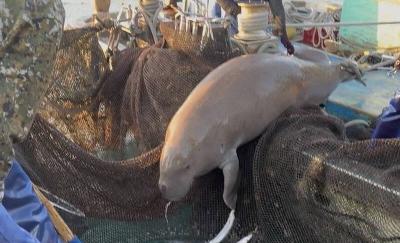As the cage holding an endangered Formosan black bear swung open, conservationists blasted gunshots and air horns to ensure the frightened young bear disappeared quickly into the mountains of central Taiwan, hopefully far from human contact.
Ziman, a one-and-a-half-year-old bear, had finally recovered from the amputation of a paw caused by a hunter’s steel noose and now had a second chance in life.
“Please take care of him and help him find his parents safely,” prayed Pihao Payen, the leader of a nearby Atayal community, as Ziman disappeared from sight.

Photo: Ann Wang, Reuters
Taiwanese hunters and conservationists are teaming up to protect the remaining few hundred Formosan black bears by designing new traps which would not amputate an animal’s limbs if they are accidentally caught in the snare. While bears are not a target for indigenous Taiwanese hunters, people in Pihao Payen’s village accidentally caught bears twice in recent years in traps for prey such as deer and boars, a traditional practice in their culture.
Since 2014, 18 bears have been captured in traps, with six found dead, the Taiwan Black Bear Conservation Association said. While most of the bears were released, some suffered major injuries caused by old-fashioned hunting tools such as metal snares, which can break bones or sever paws or toes as the bear struggles to break free.
“Steel snares bounce off from the ground and tighten when triggered by animals,” said Liu Li-wen, an animal caretaker who oversaw Ziman’s recovery.
“The snare turned tighter and tighter as the animal struggled. When blood circulation stopped, his entire paw turned necrotic,” she said, showing pictures of Ziman’s swollen left paw. Vets had to cut most of the paw off to save the cub’s life after two months of treatment.
“That is why we are seeing many bears with broken paws or toes in the wild. It is likely that they were entangled in traps, broke free by themselves and survived,” she said.
The Formosan black bear is one of the seven subspecies of the Asiatic black bear and is considered by the International Union for Conservation of Nature as vulnerable to extinction. Indigenous to sub-tropical Taiwan, it has an iconic V-shaped white mark on its chest and is seen as a symbol of Taiwanese identity that champions its diverse culture and freedom. Democratic Taiwan was also previously better known internationally as Formosa.
To reduce death or injuries of wildlife, the Forestry and Nature Conservation Agency is urging hunters and farmers to adopt a new type of animal snare designed to trap only smaller prey and which does not tighten to the point of amputation.
More than 5,600 such traps have been given to hunters and farmers for free across mountainous Taiwan, which is 60 percent covered by forests, while monetary rewards are given to those who report cases of bears caught by traps.
“Because of its small size and because the bear’s palm is very wide, you see that it [the bear paw] would not fall in completely when stepped on like this,” said Pan Wen-ming, an Amis hunter and guava farmer in central Taiwan, as he demonstrated how to set up the new trap to Reuters reporters.
“It tries to minimize [bear injuries] while letting the elders and hunters of our tribe still hunt for prey,” he said.
Some hunters kill snared bears for fear of being prosecuted for trapping a protected animal, Wushikeng Research Center bear shelter chief Chen Yen-long said.
Sadly, Ziman was found dead in the central mountains only weeks after his release, with authorities unable to determine cause of death.
“This is not the end of the story. We will not stop what we are doing,” said Lai Chiao-ling, one of Ziman’s caretakers. “At least there are still bears in the wild for us to save.”

‘DENIAL DEFENSE’: The US would increase its military presence with uncrewed ships, and submarines, while boosting defense in the Indo-Pacific, a Pete Hegseth memo said The US is reorienting its military strategy to focus primarily on deterring a potential Chinese invasion of Taiwan, a memo signed by US Secretary of Defense Pete Hegseth showed. The memo also called on Taiwan to increase its defense spending. The document, known as the “Interim National Defense Strategic Guidance,” was distributed this month and detailed the national defense plans of US President Donald Trump’s administration, an article in the Washington Post said on Saturday. It outlines how the US can prepare for a potential war with China and defend itself from threats in the “near abroad,” including Greenland and the Panama

A wild live dugong was found in Taiwan for the first time in 88 years, after it was accidentally caught by a fisher’s net on Tuesday in Yilan County’s Fenniaolin (粉鳥林). This is the first sighting of the species in Taiwan since 1937, having already been considered “extinct” in the country and considered as “vulnerable” by the International Union for Conservation of Nature. A fisher surnamed Chen (陳) went to Fenniaolin to collect the fish in his netting, but instead caught a 3m long, 500kg dugong. The fisher released the animal back into the wild, not realizing it was an endangered species at

The Chinese Nationalist Party (KMT) is maintaining close ties with Beijing, the Democratic Progressive Party (DPP) said yesterday, hours after a new round of Chinese military drills in the Taiwan Strait began. Political parties in a democracy have a responsibility to be loyal to the nation and defend its sovereignty, DPP spokesman Justin Wu (吳崢) told a news conference in Taipei. His comments came hours after Beijing announced via Chinese state media that the Chinese People’s Liberation Army’s Eastern Theater Command was holding large-scale drills simulating a multi-pronged attack on Taiwan. Contrary to the KMT’s claims that it is staunchly anti-communist, KMT Deputy

The High Prosecutors’ Office yesterday withdrew an appeal against the acquittal of a former bank manager 22 years after his death, marking Taiwan’s first instance of prosecutors rendering posthumous justice to a wrongfully convicted defendant. Chu Ching-en (諸慶恩) — formerly a manager at the Taipei branch of BNP Paribas — was in 1999 accused by Weng Mao-chung (翁茂鍾), then-president of Chia Her Industrial Co, of forging a request for a fixed deposit of US$10 million by I-Hwa Industrial Co, a subsidiary of Chia Her, which was used as collateral. Chu was ruled not guilty in the first trial, but was found guilty